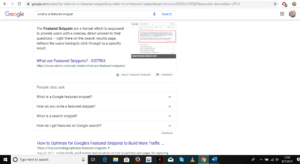It’s the festive holiday season! You’ve trimmed the tree, hung the stockings with care, and decked the halls with boughs of holly. But did you remember to include your website on your shopping list?
The best gift you can give your website this time of year (or any time of year) is a thorough SEO treatment! You’ll see the benefits in return.
Unfortunately, some scrooges are so stingy they cut corners by using black hat tactics to try to promote their websites. These tricks will earn you the online equivalent of lumps of coal in your website’s stocking.
How, exactly? Read on to find out more about black hat SEO tactics you should avoid.
This is part two in a set of blog posts about black hat SEO. You can read part one here. Both of these posts belong to the more comprehensive, and growing, Holiday SEO Series. Be sure to check out the rest of the installments.
A Reminder about the Dangers of Black Hat SEO
In case you’d forgotten, let us at TCM remind you that black hat SEO is bad. You should avoid it at all costs. The potential short-term gains that you might see from embracing underhanded online trickery are sure to be negated by the penalties that Google will stick you with once you get caught. And you will get caught.
Google’s algorithm is sophisticated enough these days to detect when developers and bloggers have taken shortcuts to attempt to cheat their way to the top of the organic search engine results. We covered this in part one of this mini-series in a previous post, along with a handful of devious practices embraced by the unscrupulous among us. In that post, we detailed keyword stuffing, invisible text, and cloaking. What follows is a rundown of several other tricks you should stay away from, lest Google end up being the grinch that steals your website’s Christmas.
A Quick Note about Domain Authority
If you run a website, you want it to have a high domain authority (DA). Domain authority is a measurement devised by the SEO gurus at Moz. It describes where any given website is likely to rank in search engine results pages.
All scores are relative and should be compared to those of sites that are similar to yours. That said, the higher your site’s score is, the better. (In other words, if your site promotes SEO services in Canton, Ohio, compare its DA to those of other businesses in your area that provide the same service, rather than, say, YouTube.)
One of the ways that you can increase your DA score is by getting lots of backlinks from other sites on the web. This is the equivalent of other sites vouching for your site, its content, its security, and so on.
Don’t Make Merry with these Black Hat SEO Tactics
Some black hat SEO tactics attempt to game the link-building system to increase DA. Others try to cheat when it comes to content. None of them are your friends.
You should avoid going caroling with them, standing under the mistletoe near them, and getting in their sleighs.
Private Blog Networks
Some might argue that private blog networks (PBNs) could be considered gray hat techniques, as they aren’t as nefarious as the worst-of-the-worst black hat cheats.
Like many black hat SEO tricks, utilizing PBNs might give you an initial boost. This might tempt you to try them out, but TCM warns you to avoid them. After all, Google has taken steps in the past to penalize sites that participate in them. This should tell you all that you need to know about PBNs.
That said, it’s not a crime to learn about how PBNs are set up. Think of this as Law & Order: PBN.
Basically, PBNs create an unearned backlink structure meant to benefit your site. You can design one by buying up expired domain names that have decent DA scores. Then you compose some rudimentary content, place that on each of these purchased sites, and have them all link back to the site you really want browsers to find in order to increase that site’s DA.
So, yes, all of these other sites will link back to your chosen site. It sounds good, but in reality, it’s like putting the site you want to promote at the center of a circular firing squad.
If Google notices that all or most of the sites that link to your favorite have very basic content and that no one ever really updates them, that’s a red flag. And, trust us, Google will notice.
Building links can be a slow process, we know. But earning them organically by creating high-quality content that users will find informative and link to on their own is a lot less dangerous in the long run.
Buying Links
If a PBN scheme is too complicated for you, then you could just buy up a bunch of links to your site!
Yes, you could do this, but you absolutely should not.
As you might expect, link buying is basically what its name says that it is. You pay some service to create a bunch of links to your site as a way of trying to build DA quickly.
The problem is that online, as in life, you’re often judged largely by the company you keep. Guys who sell links for a living may not be producing any good content of their own. They may be sending you links from sites that don’t have any real DA themselves, and aren’t worth the money you’ve paid for them. Plus, if the sites that are linking to yours aren’t particularly relevant to your business, then the whole scheme looks unnatural. And that’s probably not going to help your SEO efforts very much.
Duplicate Content and Article Spinning
We hope you learned in elementary school that copying off of your neighbor’s paper in class is cheating. Cutting and pasting someone else’s content in your website and claiming it as your own is plagiarism. It’s bad. Don’t do it. You will get caught.
But duplicating your own content and placing it on multiple pages within your own site, is also something you should avoid. (We discussed how you might do this unintentionally in a previous post in the Holiday SEO Series.)
Creating high-quality content is time-consuming. But that’s a big part of why it’s so valuable!
Article spinning attempts to get around the hard work requirement associated with fine content by just retooling existing content.
This black hat tactic involves using software to chop up articles and then reassemble them, presenting the messy product as a brand-new piece of content.
The problem is that the result is often of very poor quality. In addition, it might not be retooled enough to even be considered “new” at all. Who’s going to want to consume this online equivalent of a fruitcake?
Machines are becoming more sophisticated all the time, but, for now, content produced by humans is still going to be better. Don’t get software to spin your content for you. And don’t try to spin your own content either. It’s better to invest the time you would spend doing that in creating new content. It’s worth it.
In Conclusion
Enjoy the holiday season! Give yourself the gift of white hat SEO. Don’t engage in shady black hat tactics that may give your site a brief boost, but come back to bite you in the end.
Black hat SEO might promise your website the world (wide web), but in the end, it’s all just a big humbug.


















